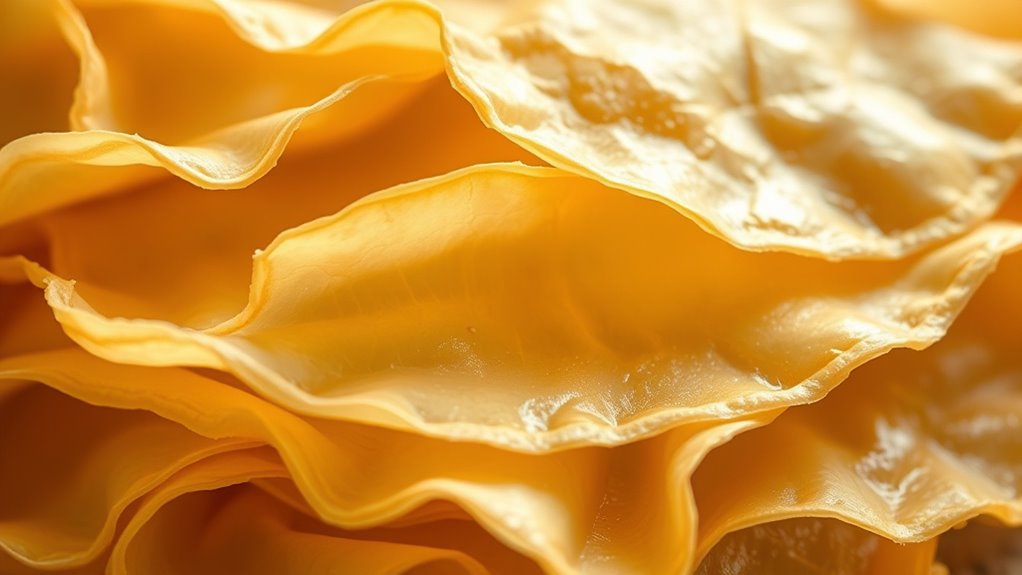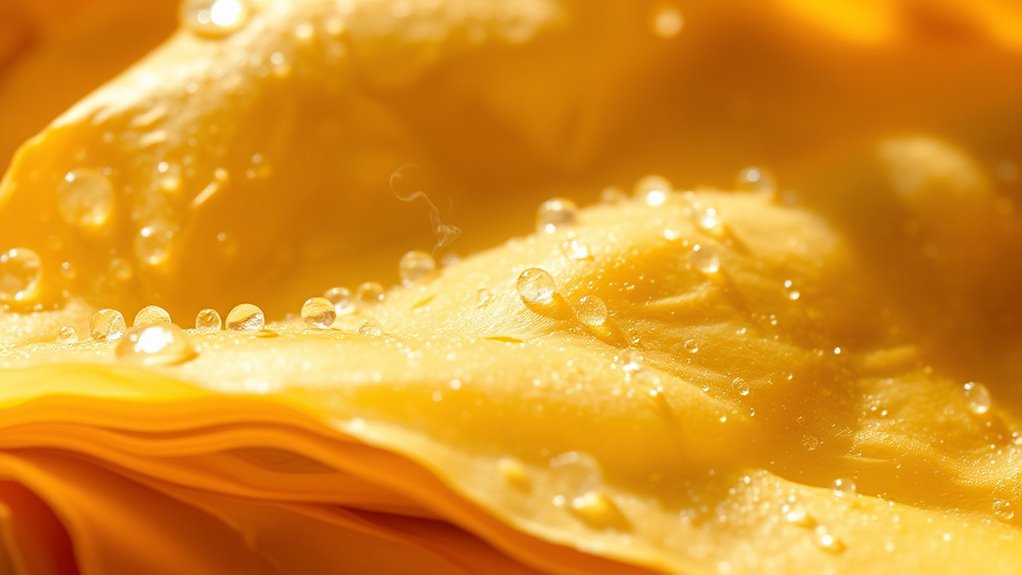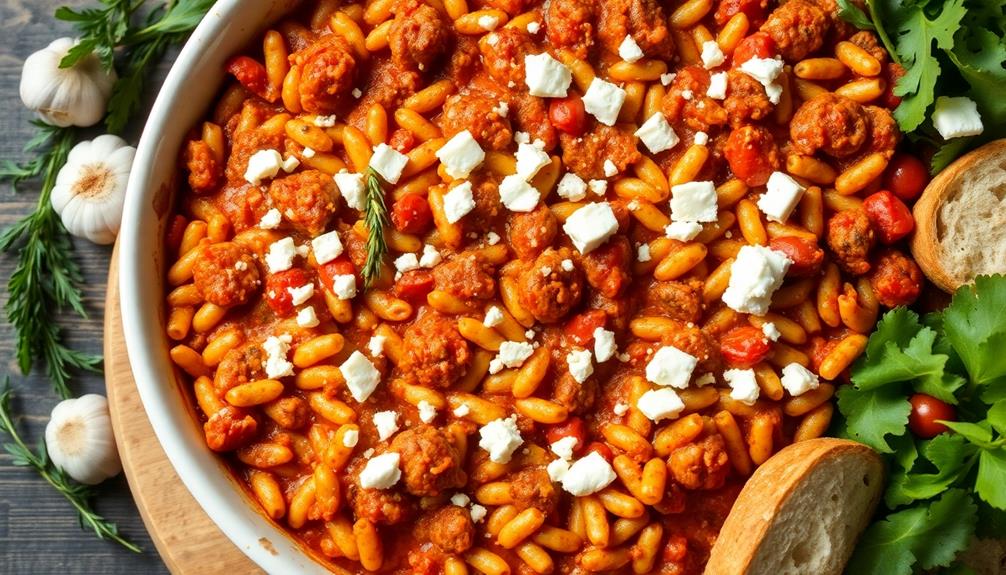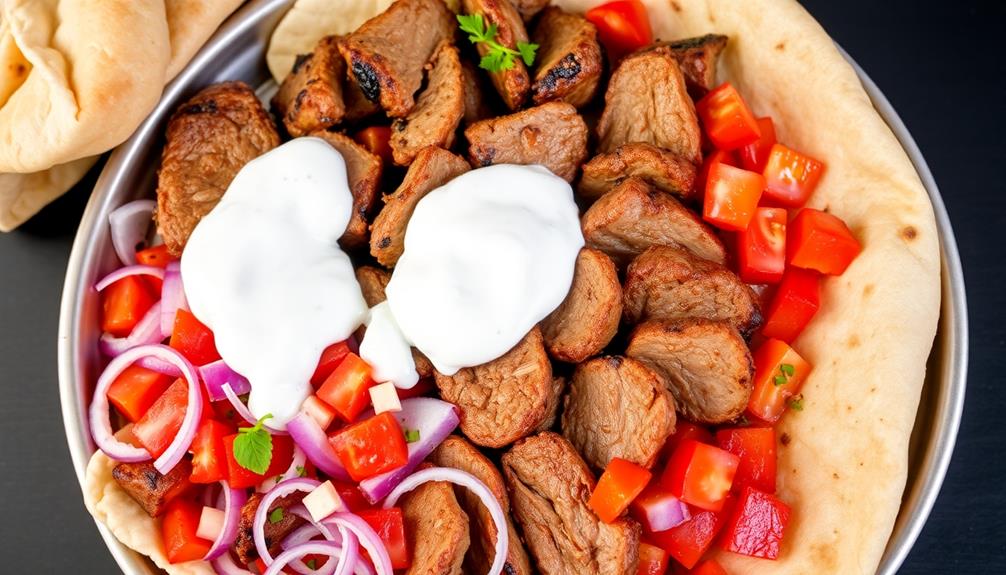Humidity greatly affects the flakiness of Greek phyllo pastry by influencing how the dough handles and layers. In humid conditions, dough sheets tend to get sticky, making them tricky to work with and risking tears or uneven layers. On dry days, the dough can become brittle and hard to manage. Adjusting your butter application and layering techniques to the environment can help you achieve consistently flaky, crispy results—if you continue exploring, you’ll master these essential nuances.
Key Takeaways
- High humidity makes dough sheets sticky, increasing the risk of tearing and uneven layers during layering.
- In dry conditions, dough becomes brittle, requiring careful handling and adjustments to maintain flakiness.
- Moisture levels influence butter adhesion and layering, affecting the pastry’s crispness and puffiness.
- Controlling ambient humidity helps achieve consistent dough pliability and optimal flaky texture.
- Adjusting techniques based on humidity ensures even layers and prevents issues like sticking or dryness.

Have you ever wondered what makes Greek phyllo pastry so uniquely delicious and versatile? The secret lies in the delicate process of dough layering combined with careful butter application. When making phyllo, you start with thin sheets of dough that are expertly layered to create that signature flaky texture. Each sheet must be brushed with melted butter, which not only adds flavor but also helps the layers stick together, creating a crisp, airy crunch when baked. The way you handle this butter application and layering process directly influences how flaky and tender your pastry turns out.
As you work with the dough, it’s essential to keep the sheets covered with a damp cloth to prevent them from drying out. When layering, you gently lift and drape each sheet over the previous one, making sure to evenly brush butter between each layer. This step is vital because it promotes uniform separation of the layers and ensures that each one is coated with enough butter to develop that crisp, golden exterior. If you skip or skimp on butter application, the layers may stick together or become dense, resulting in a heavier, less flaky pastry. Conversely, too much butter can make the pastry greasy and prevent proper puffing. Striking the right balance during dough layering and butter application is key to achieving perfect flakiness.
Humidity plays a significant role in this process. When the air is humid, the moisture in the environment can make the dough sheets slightly tacky or sticky, complicating the layering process. This stickiness can cause the sheets to tear or stick together, disrupting the even distribution of layers. To counteract this, you might need to work more quickly or lightly dust the sheets with a little flour or cornstarch to prevent sticking. On the other hand, in a dry environment, the dough can become too brittle, making it challenging to handle and layer smoothly without cracking or tearing. In such cases, slightly increasing the butter application can help keep the sheets pliable and manageable.
Controlling humidity levels is crucial because it directly affects the dough’s texture and handling properties, ultimately influencing the final flakiness of your pastry. Proper dough moisture content is also essential, as it ensures that the sheets remain pliable and easy to work with, especially in challenging environmental conditions. Additionally, maintaining appropriate dough handling techniques helps prevent tearing or uneven layers, which can compromise the pastry’s texture. Understanding the impact of environment allows bakers to adapt their methods accordingly, ensuring consistent results regardless of weather conditions. Ultimately, controlling humidity and paying close attention during dough layering and butter application will help you produce phyllo pastry with the perfect flaky, tender texture. Whether it’s a hot, humid day or a dry one, adjusting your technique ensures that each layer remains distinct and crisp, giving your baked goods that irresistible crunch. Mastering these details makes all the difference, turning simple ingredients into a beautifully flaky, mouth-watering pastry every time.
Frequently Asked Questions
How Does Humidity Affect the Shelf Life of Phyllo Pastry?
Humidity influences the shelf life of phyllo pastry by causing moisture absorption, which can make the layers sticky and less flaky. Increased moisture also creates a perfect environment for mold growth, reducing freshness and safety. To extend its shelf life, you should store the pastry in an airtight container in a cool, dry place, preventing humidity from compromising its texture and preventing mold from developing.
Can Humidity Variations Change the Nutritional Content of Phyllo Dough?
Humidity variations can influence the nutritional content of phyllo dough through moisture absorption, which may dilute some nutrients. However, the overall nutrient stability remains mostly unaffected if the dough is stored properly. You should keep the dough in a sealed container to prevent excess moisture from changing its composition. Proper storage helps maintain both the dough’s nutritional value and its quality, ensuring it stays fresh and healthy for your recipes.
What Are the Best Storage Methods for Phyllo in Humid Climates?
So, you want to store phyllo in a humid climate? Ironically, your best bet is to keep it airtight—think sealed containers—and toss in desiccant packs to absorb moisture. This way, you’re fighting humidity’s sneaky invasion, preserving that delicate flakiness. Avoid the fridge, as moisture here can turn your crisp layers into soggy messes. With these tips, your phyllo stays flaky and perfect, no matter the weather outside.
How Does Humidity Influence the Flavor Development of Baked Phyllo Pastries?
Humidity plays a key role in flavor development and aroma enhancement in baked phyllo pastries. When humidity levels are high, moisture can dampen the pastry, dulling its aroma and subtle flavors. Conversely, low humidity helps crisp the layers, intensifying the aroma and allowing flavors like butter or spices to stand out. You’ll notice better flavor enhancement and richer aroma development when you control humidity, ensuring your pastry turns out perfectly crispy and flavorful.
Are There Specific Ingredients That Help Resist Humidity-Related Issues in Phyllo?
Think of ingredient stability as your shield against humidity’s relentless assault. To resist moisture-related issues in phyllo, you should choose ingredients that offer moisture resistance, like high-quality fats and stabilizers. These act like armor, maintaining flakiness and preventing sogginess. Using ingredients with proven moisture resistance guarantees your pastry remains crisp and flaky, even in humid environments, giving you a reliable foundation despite the weather’s unpredictable nature.
Conclusion
When you master the gentle balance of humidity, your Greek phyllo pastry becomes a whisper of perfection—light, flaky, and irresistible. A touch too much moisture, and it may soften just enough to charm your senses differently; too little, and it crumbles before your eyes. Embrace the subtle dance of environment and technique, and you’ll find each flaky layer telling a story of craftsmanship. With patience and care, your pastry will always invite curiosity and delight.









